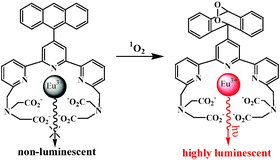A new europium chelate, [4′-(9-anthryl)-2,2′:6′,2′′-terpyridine-6,6′′-diyl]bis(methylenenitrilo) tetrakis(acetate)-Eu3+
(ATTA-Eu3+), has been designed and synthesized as a highly sensitive and selective time-resolved phosphorescence probe for singlet oxygen (1O2). The probe can specifically react with 1O2 to yield its endoperoxide (EP-ATTA-Eu3+) with a great increase of the luminescence quantum yield and a long phosphorescence lifetime of 1.21 ms, which renders the probe favorable to be used for highly sensitive time-resolved luminescence detection of 1O2. The new phosphorescence probe is highly water soluble with a large stability constant of ∼1020 and a wide available pH range at pH > 3. Upon reactions with some reactive oxygen species including hydrogen peroxide, superoxide, hydroxyl radical and 1O2, the probe shows high specificity for 1O2. The probe was used for quantitative detection of 1O2 generated from a MoO42−–H2O2 system to give a detection limit of 2.8 nM. Furthermore, the good applicability of the probe was demonstrated by the real-time monitoring of the kinetic process of 1O2 generation in a horseradish peroxidase (HRP) catalyzed oxidation system of indole-3-acetic acid (IAA) in a weakly acidic buffer and in a photosensitization system of 5,10,15,20-tetrakis(N-methyl-4-pyridyl)-21H,23H-porphine (TMPyP) in a neutral buffer.

You have access to this article
 Please wait while we load your content...
Something went wrong. Try again?
Please wait while we load your content...
Something went wrong. Try again?


 Please wait while we load your content...
Please wait while we load your content...